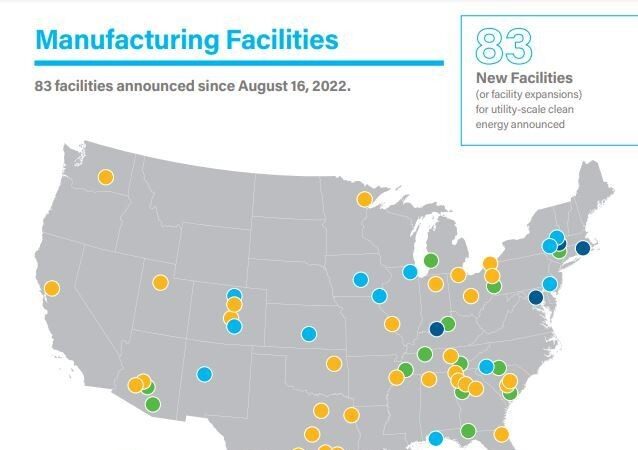Top energy news: The massive impact of the US Inflation Reduction Act, plus other top energy stories this week

- This week’s round-up brings you the latest developments in the global energy sector.
- Top energy news: The impact of the US Inflation Reduction Act; Africa ready for energy growth; Saudi Arabia secures mining stakes for decarbonizing metals
- For more on the World Economic Forum’s work in the energy space, visit the Centre for Energy and Materials.
1. The effect of the US Inflation Reduction Act: Report
Since the launch of the US’ Inflation Reduction Act (IRA) a year ago, eight years’ worth of clean energy investment has taken place in the country, equivalent to more than $270 billion.
After years of inertia caused by battles over energy taxation and regulation, the US last year announced a package of decarbonization initiatives that are having a powerful effect.
The new Clean Energy Investing in America report from the American Clean Power Association (ACPA) also points to 83 new or expanded clean energy manufacturing facilities that will bring nearly 30,000 new jobs, as well as $4.5 billion in savings for millions of Americans.
ACP projects a near-ninefold increase in solar module output as well as a fifteen fold increase in grid-scale battery storage.
“The past year has sown the seeds of nothing short of a clean energy revolution,” ACPA chief executive Jason Grumet said.
2. Africa ready for energy growth and decarbonization
Africa could be the answer to Europe’s gas availability challenges, as well as its own longer-term decarbonization challenge, The Economist writes.
Africa has 13% of global gas reserves, slightly less than the Middle East, 7% of the world’s oil reserves and significant green-energy potential.
African energy could “become really central for the future for Europe—and not just for Europe,” says energy producer Eni’s chief executive Claudio Descalzi.
Africa is ramping up LNG projects, including two multi-billion dollar projects in Tanzania and Mozambique. New gas projects in sub-Saharan Africa could contribute around 90 billion cubic metres (bcm) in annual LNG capacity by 2030, more than enough to offset the 70 bcm fall in Russian gas exports to the EU between 2021 and 2022.
But the continent also has vast renewable energy potential, with long hours of sunshine, windy coasts and plains, and suitable rivers that all make solar, wind and wave power projects more viable.
Investment is key to reaching Africa’s full energy potential, after years of declining market shares in global energy markets. And many believe that Africa has a huge opportunity now; “This century is Africa’s century,” said energy producer Chariot CEO Adonis Pouroulis.
3. News in brief: More energy stories from around the world
India plans to utilize its increasing renewable energy capacity by exporting some of it to southeast Asian countries via Myanmar and Thailand, Reuters reports. India already has plans to connect the Indian electricity grid with the UAE grid, as well as plans to collaborate on renewable energy projects.
Saudi Arabia has secured a 10% interest in multiple mines from Canada to Indonesia, producing copper, nickel and other important decarbonizing metals. The deal comes at a time when global decarbonization is reliant, in part, on having access to the right raw materials. “Mining is going to be the third most important industry in the Kingdom,” Saudi businessman Amr Khashoggi told Arab News.
A return to more traditional ways to propel ships may be on the rise after the maiden voyage of Pyxis Ocean, a cargo ship fitted with rigid sails, designed to cut fuel consumption and emissions.
The EU has reached its 90% gas storage target ahead of winter, after a series of successful initiatives were rolled out last year in the wake of the invasion of Ukraine.
The nuclear debate continues, with some nations embracing it, while others are in the process of shutting down plants. The Financial Times discusses the case for and against nuclear power.
European countries are planning a 3,300km green hydrogen pipeline to meet energy demand, write The Financial Times. In Austria, Germany and Italy, a group of gas companies are working on transporting green hydrogen made from renewable energy from north Africa and Italy to northern regions to areas where reducing fossil fuel usage is more difficult.
In Ecuador, voters have rejected further oil drilling in the Yasuni National Park, home to the only remaining indigenous communities in the country, writes UK newspaper The Guardian.
The Abu Dhabi National Oil Company has announced plans to be net zero by 2045, bringing forward a previous target of 2050.
4. More on energy from Agenda
Global investment in clean energy is accelerating, with $1.34 trillion allocated by policymakers since 2020. Which countries are leading the charge and which ones are playing catch up?
A significant amount of heat is wasted from industrial, commercial, and institutional sources. Here’s how we can reuse waste energy to achieve net-zero heating systems.
Developing economies cannot fund their energy transitions without significant international investment. Here are the main financial challenges for emerging economies and three innovative ways to approach them.
To learn more about the work of the Centre for Energy and Materials, contact Ella Yutong Lin: [email protected]






